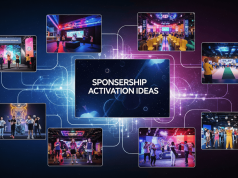The world is increasingly digital and this has changed the landscape of how companies reach and connect with their audiences. Virtual events sponsorship has quickly become a valuable tool for companies seeking to stay in touch with consumers even as their behavior changes.
Businesses, no matter the sector, are now realising some unique benefits of sponsoring virtual events over the in-person alternative. From the low cost, widespread reach, and detailed analytics, the benefits don’t end there. The real trick is to deliver genuine engagement that online audiences can identify with.
This ultimate guide delves into the things you must do when looking for sponsorship to your virtual event. You will discover how to identify the best events, create engaging sponsor experiences and measure your impact.
Understanding Virtual Events Sponsorship
“Virtual events sponsorship” is when companies work with online events to reach out to audiences about their brands, products, services or tech solutions. In contrast to sponsorships of old, virtual sponsorships demand novel engagement strategies.
The sponsorship game has changed. Stands and printed materials have been replaced by live digital interactions. Sponsors are now able to see live data of attendees activities, engagement trend and the conversion statistics.

Key Differences from Traditional Sponsorship
There are a number of advantages associated with virtual sponsorship:
Cost Effectiveness
No need to pay for travel, shipping or booth build out. In most cases, virtual sponsorships are anywhere from 30%-50% less expensive than an equal in-person event.
Extended Reach
Geographic boundaries disappear. If you schedule a virtual event, people from virtually anywhere can participate and your potential audience widens dramatically.
Rich Data Atmosphere
Each click, each interaction is a valuable piece of data. This enables you to refine your sponsorship program on the fly.
Flexibility
Virtual sponsorship can be scaled up or down based on ROI or the business’ needs.
Selecting the Right Virtual Events
Picking the right virtual event can be challenging to sponsor, many factors need to be considered. Finding the perfect event is key to getting the best ROI and brand perception.
Audience Alignment
Begin by considering the attendees at the event. Browse previous attendees by demographics, job titles, industries, and location. This data should be as closely aligned to your ideal customer profile as possible.
Ask event organizers for specific data on the event audience. Most professional events will also make available detailed attendee profiles that include information about the size of the company an attendee works for, what their decision-making capabilities are, and their timeline for purchasing a product or service.
Event Format and Technology
Various virtual event formats cater to a different purpose:
Webinars: Perfect for education and thought leadership. Limited interaction but high information retention.
Remote Events: Multi-session events with networking capabilities. Great for full brand visibility and lead generation.
Hybrid Gatherings: Split the difference between in-person and virtual. Provide more reach while maintaining some classic networking advantages.
Interactive Workshops: Hands-on learning experiences. Great for product videos and feature explanations.
Evaluate the technology platform carefully. Make sure it accommodates your planned sponsor activities and has enough analytics.
Industry Relevance
Choose events that coincide with your industry expertise and objectives. Industry-specific virtual events tend to draw a higher level of qualified prospects and engagement.
Think about long-standing industry conferences but also niche new things popping up. Depending on the brand, more niche events can lead to higher quality of networking and better sponsor exposure.
Creating Compelling Sponsor Experiences

The key to engaging virtual event sponsorships is to deliver experiences that offer real value to attendees. Spammy adverts do next to nobody any favours on virtual platforms.
Interactive Content Strategies
Live Demo Stations: Highlight your products or services with live demonstrations. Interactive demos lead to 40 percent more engagement vs static presentations.
Expert Panels: Get your team on panels or Q&A sessions as industry experts. This establishes trust and credibility with potential clientele.
Virtual Networking: Host sponsored networking sessions or breakout rooms. They lead to more intimate settings for your team to engage with your prospects.
Game Elements: Let them play interactive games or participate in quizzes or challenges that are tied to your branding. Player engagement increases 5 to 60% in gamified activities.
Content Development
Create content that’s meant for virtual attendees. People have shorter and shorter attention online, so presentations must be very topical and dynamic.
Micro-Learning: Divide large concepts into smaller lessons. 10–15 minute talks are more effective than hour-long talks.
Visual Storytelling: Keep your audience engaged with strong visuals, animations, and multimedia. Virtual worlds are visually dominated.
Interactive Polls & Surveys: Use live polling to engage audiences and receive feedback that’s immediately usable.
Online Audience Engagement Techniques
Attracting attention online means capturing the way in which individuals behave and pay attention digitally. Engagement in virtual is much different than onsite.
Pre-Event Engagement
Begin building connections before the event ever starts. A lot of the time, your ability to achieve virtual event sponsors depends on what you do to market the event beforehand.
Social Media Campaigns: Develop social media content that builds excitement and drives registration for the event.
Email: Create email campaigns targeted against registered attendees. Share valuable content that places your brand as being a helpful resource.
Previews: Provide registered attendees with early access to content, discounts, or exclusive resources.
During-Event Strategies
Live Chat: Engage in chat with webinar speakers and panelists, Q&A and networking. Quick, informative replies make people feel better about a company’s brand.
Share: Share the material discussed during presentations: relevant links, complementary resources, etc. That’s instant value created with a corresponding value driver.
Live Support: Have a team of specially trained representatives to address questions and technical issues. This helps make the overall attendee experience much better and less stressful.
Post-Event Follow-Up
It’s true that virtual events typically attract more leads than in-person events, but closing rates rely heavily on your follow-up.
Your Immediate Response: Get in touch with interested prospects within 24 to 48 hours.
Personalization: Reference specific discussions that took place or interactions you had during the event. Follow-up messages personalized by 35% respond better.
Value-Added Elements: Post other content, case studies, and resources to continue the event journey and provide year-round value.
Measuring Virtual Sponsorship Success
Effective measurement means defining objectives and noting the metrics and KPIs to follow for the life of the sponsorship.
Key Performance Indicators
Engagement Metrics:
- Session attendance rates
- Content downloads
- Chat participation
- Poll responses
- Networking session attendance
Lead Generation:
- Contact information collected
- Demo requests
- Follow-up meeting scheduling
- Sales qualified leads generated
Brand Awareness:
- Social media mentions
- Website traffic increases
- Brand search volume changes
- Media coverage generated
- Advanced Analytics
Virtual events offer analytics that in-person events can only dream of. Use this information to refine your sponsorship game.
Behavioral Tracking: Keep an eye on how people are engaging with your content. Look at which materials are receiving the most engagement.
Track Conversions: Trace leads down your sales funnel to find out which virtual events generated the best quality leads.
ROI Measurement: Measure ROI by comparing total cost of sponsorship to revenue from event leads.
Technology and Platform Considerations
The virtual event software you use has the largest impact on your sponsorship success. You have to know about platform capabilities and limitations to better plan your strategy.
Platform Features
Integration Capabilities: The platform should integrate with CRM, marketing automation, and analytics tools to support your marketing efforts. Smooth data transition streamlines lead management and follow-up processes.
Customization: Seek solutions that enable sponsor branding, customization of booths, and personalized attendee experiences.
Mobile-Ready: Make sure the system delivers great mobile experiences. Over 45% of virtual event attendees engage on their mobile device at least in part.
Technical Requirements
Bandwidth: Make sure your team has enough bandwidth to support you for live demonstrations or instant communication.
Back-Up Plans: Have a plan for technical issues. Having back-up facilitators and methods for delivering content in other forms helps avoid downtime.
Platform Training: Train all your involved team members in the platform that attendees will experience.
Budget Optimization Strategies
Virtual event sponsorships generally cost less than traditional events, but in order to recoup your investment, it’s key to budget effectively.
Cost Structure Analysis
Sponsorship Level: Review the different packages and what is included. The more you can invest, the more valuable it may be per dollar spent.
Content Creation: Allocate a budget for the production of professional virtual content. Professional video production and interactive materials come with a cost but with better results.
Technology Expenses: Account for any technology needs, software licensing, or platform fees.
Time and Staff: Determine the time your staff must prepare for, attend, participate in, and follow up after the event.
ROI Optimization
Lead Quality Centered: Concentrate on the events that high-quality leads attend instead of the ones with broader but lower quality audiences.
Multi-Event Strategy: Create content and materials that are adjustable for other virtual events to share the cost across expos and tradeshows.
Partner Opportunities: Consider co-oping with related businesses to split costs and expand reach together!
Future Trends in Virtual Sponsorship
Sponsoring virtual events is constantly evolving since technology is accelerating and attendees demand more. Identifying the emerging trends is beneficial to set long-term strategies.
Hybrid Event Integration
The future will probably consist of more hybrid events that incorporate both in-person and virtual elements. This approach gives sponsors the best of both worlds: the wide, virtual reach, and the closer-to-the-ground in-person connection.
Enhanced Personalization
AI and ML will make sponsor experiences more personalized. Delegates will receive tailored daily content recommendations and networking tips according to their preferences and interactions.
Immersive Technologies
VR and AR technologies will increase sponsor experiences. They enable demos and brand experiences that closely mimic a face-to-face experience.
Building Long-Term Virtual Sponsorship Success
Virtual event sponsorship demands a strategic and long-term approach that leverages every gathering you host.
Relationship Building
Work on cultivating long-term relationships with event organizers, key influencers, and attendees. These connections are more valuable than any individual event outcome.
Continuous Improvement
Evaluate each virtual sponsorship for possible advances. Experiment and pivot when needed.
Community Development
Utilize virtual events to develop online communities based on your business. Communities that are engaged are a continued source of marketing and customer loyalty.
The opportunity of virtual event sponsorship is massive for brands willing to adapt strategies to the digital space. Success depends on understanding online audience behavior, generating effective interactive experiences, and making the most of technology.
Begin with events that are a tight fit with your audience and company goals. Create compelling content, designed for online consumption, and measure your success!
The future of virtual events sponsorship is looking up, with new technologies set to deliver even more engaging and effective sponsor experiences. The companies that get it right with virtual sponsorship today will be in a good place to take advantage of these opportunities when they do come.
Ready to see what event sponsorships in the online world can do for your business? Start by looking into future virtual events in your niche and coming up with potential sponsorships. The online audience is here to stay and the time to seize it couldn’t be better.




